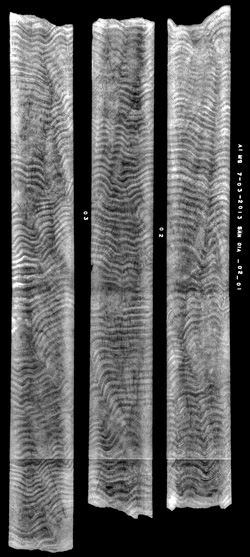Coral cores
AIMS’s extensive collection of coral cores has provided important insights into historical coral growth rates and climate impacts.
The skeletons of certain massive corals (such as Porites) contain annual density bands, similar to tree rings, which are visible when coral slices are X-rayed.
These natural historical archives contain records of coral growth rates, climate and environmental variability that extend over several centuries, pre-dating both observational records of reef environments and human interference in regional and global environments.
They help our researchers understand past climate conditions and how coral growth responded to environmental changes, allowing us to better understand how corals might respond to ongoing climate change.
This information can help us test and refine global climate models, giving us greater confidence in modelled future climates and helping us to manage reefs so that they are healthy and resilient.
Our research
In an era of rapid environmental changes, coral cores provide our only means of obtaining many historical insights.
For example, these records reveal growth hiatuses associated with recent mass bleaching events, which are rare in the records predating the late 20th century. A 2014 AIMS study of the central Great Barrier Reef used our coral cores to demonstrate how bleaching events could suppress growth rates for up to four years.
Analysis of the geochemical composition of the coral skeleton can also provide proxy measurements for water temperature, salinity and sediment extending back several centuries.
Another 2014 AIMS study has used these geochemical records to reconstruct the strength and water temperatures of the Leeuwin Current, off south-western Western Australia, back to 1795. This extended record shows that extreme sea levels and unusually warm sea surface temperature anomalies have occurred after 1980 and are unprecedented in severity in the past 215 years.
When placed under ultraviolet light, slices of corals from nearshore reefs show bright luminescent lines that are directly related to the occurrence and intensity of freshwater flood and rainfall events on the Great Barrier Reef.
This has allowed our scientists to reconstruct Queensland rainfall and freshwater flow into the Reef back to the early 17th century, tripling the length of instrumental records for the region.
Massive corals can also be well preserved after death, giving insights into annual coral growth rates and environmental variability for the more distant past.
One study, for example, reconstructed Burdekin River flow 6000 years ago from coral luminescence. These corals show that during this time period (the mid-Holocene), north Queensland summer rainfall was substantially lower and less variable than present.
Such observational paleoclimatic evidence provides important checks on the performance of global climate models used to predict future climates in a warming world.



